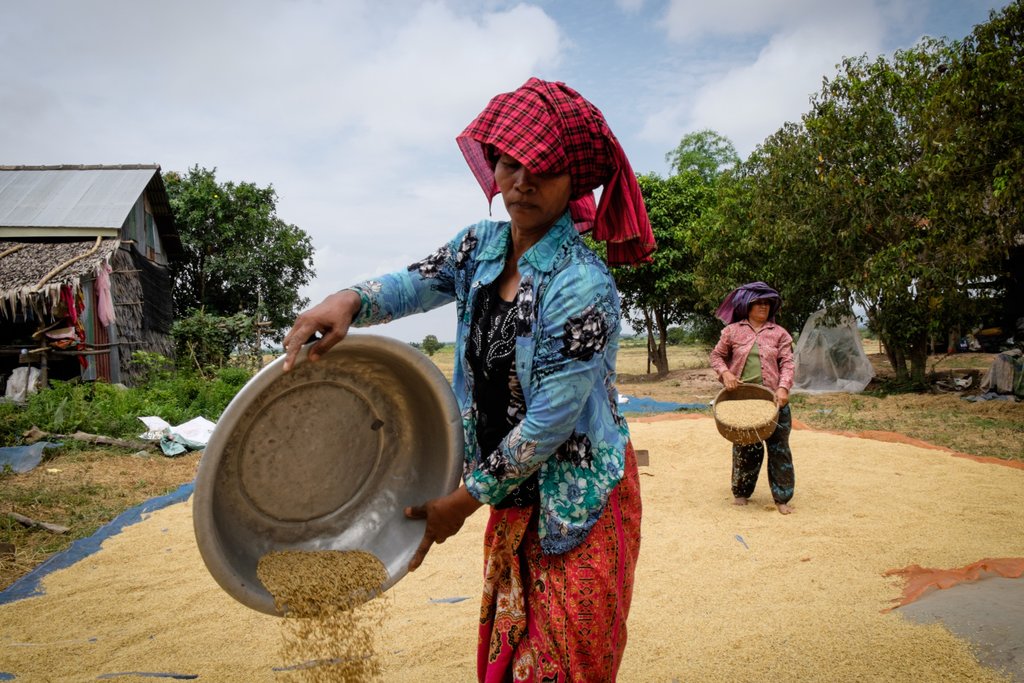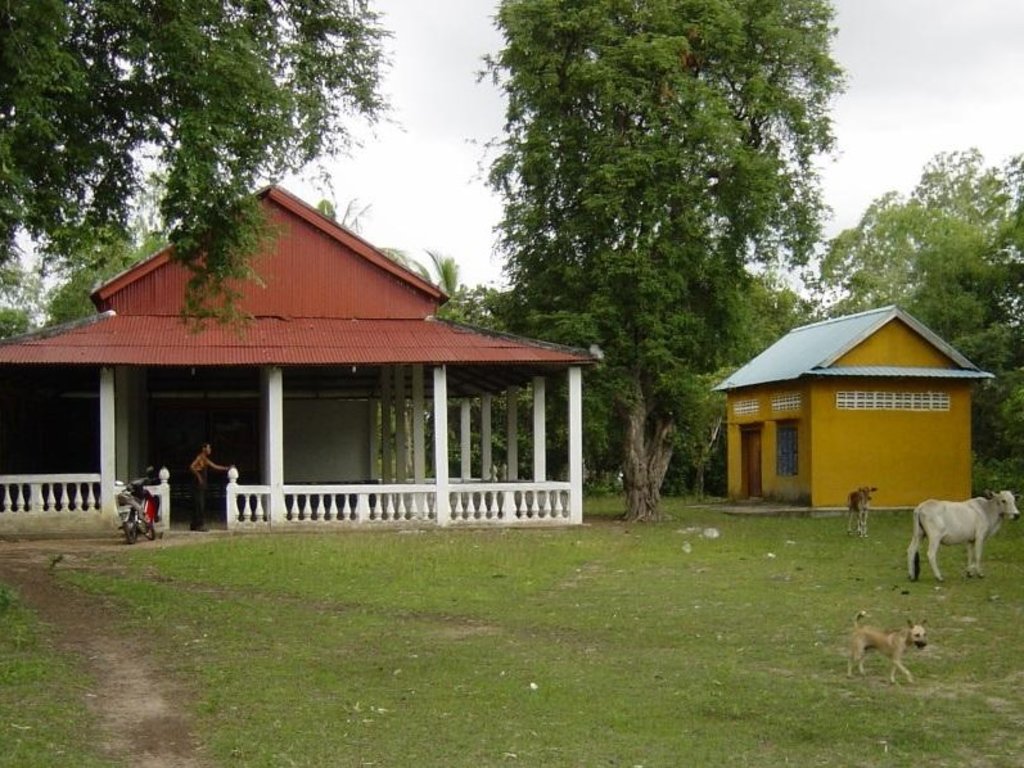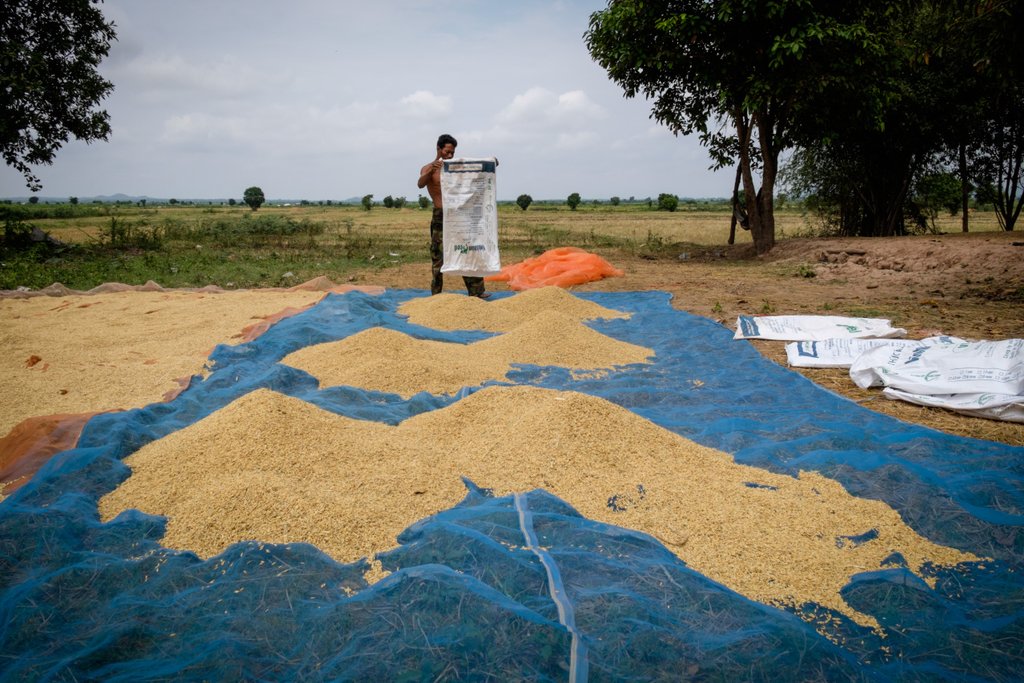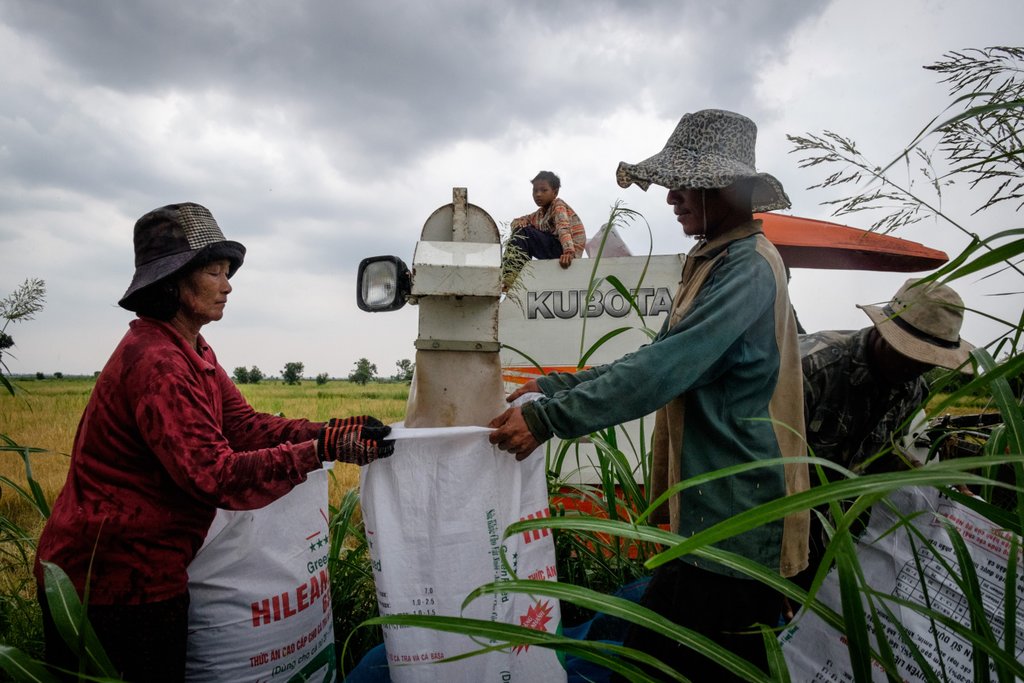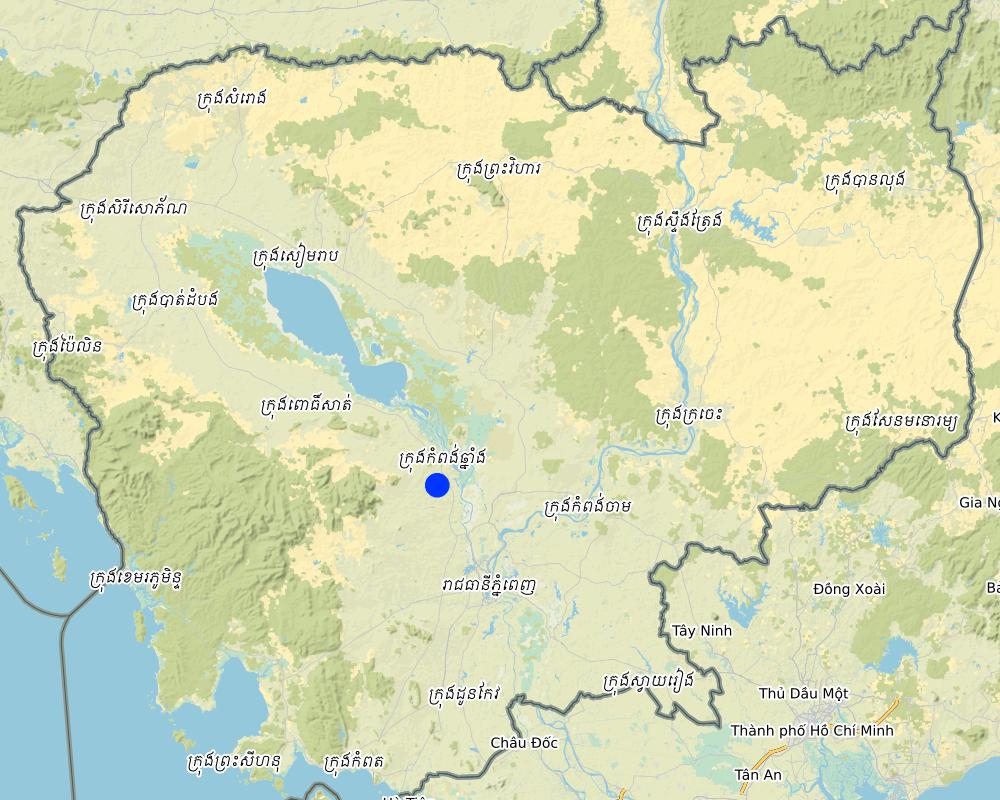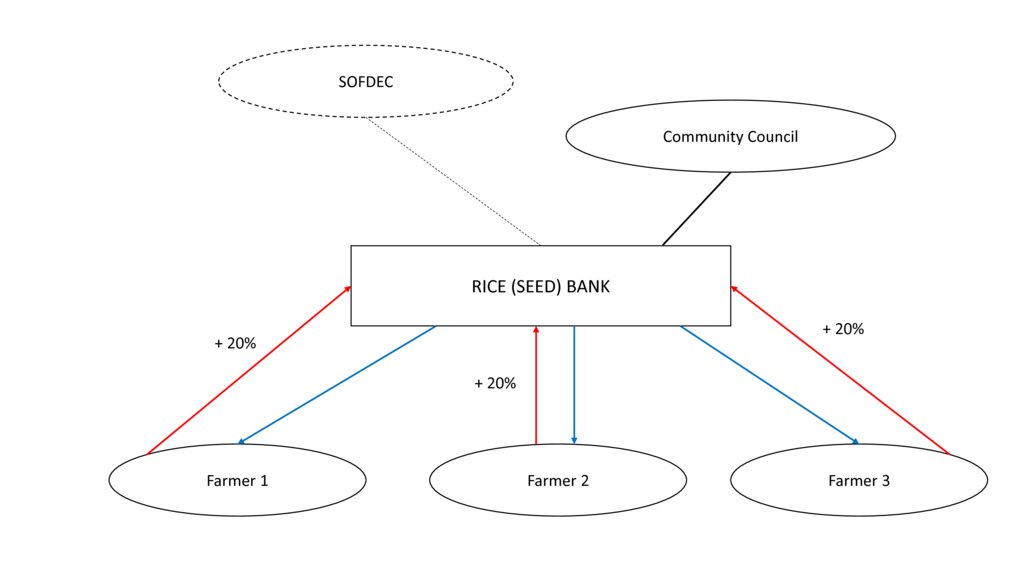Community Safety Nets - Establishment of rice seed banks at village level [柬埔寨]
- 创建:
- 更新:
- 编制者: Stefan Graf
- 编辑者: Stefan Graf, Christoph Kaufmann, Christine Lottje, Judith Macchi
- 审查者: Boris Orlowsky, Alexandra Gavilano, Judith Macchi
approaches_1848 - 柬埔寨
查看章节
全部展开 全部收起1. 一般信息
1.2 参与方法评估和文件编制的资源人员和机构的联系方式
关键资源人员
SLM专业人员:
Khun Lean Hak
kleanghak@yahoo.com / sofdec@camintel.com
SOFDEC/LAREC
柬埔寨
SLM专业人员:
Bin Sreytouch
Society for Community Development in Cambodia SOFDEC
柬埔寨
Say Mesa
Society for Community Development in Cambodia SOFDEC
柬埔寨
SLM专业人员:
Pit Khonhel
Local Agriculture Research and Extension Centre LAREC
柬埔寨
有助于对方法进行记录/评估的项目名称(如相关)
Book project: where people and their land are safer - A Compendium of Good Practices in Disaster Risk Reduction (DRR) (where people and their land are safer)1.3 关于使用通过WOCAT记录的数据的条件
(现场)数据是什么时候汇编的?:
16/04/2014
编制者和关键资源人员接受有关使用通过WOCAT记录数据的条件。:
是
2. SLM方法的描述
2.1 该方法的简要说明
A rice (seed) bank is a community safety net system where farmers can get both rice seeds for cultivation and rice for consumption from a communal storage house in order to increase their food security by guaranteeing: (1) year-round access to high quality seeds and rice for consumption, (2) access to seed and rice for consumption after an extreme weather event (drought, flood) and (3) improved quality of the planted seeds through the provision of new varieties better adapted to local conditions (e.g. fast maturing, floating rice)
2.2 该方法的详细说明
该方法的详细说明:
A rice (seed) bank is a system where farmers can get both high quality rice seeds for planting and rice for consumption from a communal storage house. Requirement for the use of the rice (seed) bank is that farmers pay back the purchased rice seeds or rice for food with a 20% interest rate after their next harvest. The bank is managed by a community council consisting of members of the village in collaboration with the local NGO Society for Community Development in Cambodia - SOFDEC.
The rice (seed) banks act as a community safety net in the villages to guarantee food security despite the threat of extreme weather events such as drought or flood. Because of the constant access to high quality seeds, farmers can sow a second time in case the first sowing was lost due to a drought or flood. Also, the communal storage of rice for consumption helps particularly poor farmer families with small plots in case they do not get enough yield on their field to feed the household.
Moreover, new rice varieties, which are better adapted to local conditions and which also perform in the case of extreme weather (fast maturing, floating rice) are introduced through the rice (seed) bank. Besides these new varieties (the result of research carried out by the Local Agricultural Research and Extension Center LAREC in collaboration with other research institutes) have higher yields and can also be sold at a better price on the market.
The need for a rice (seed) bank is decided in participatory manner by the village community. In case a bank is established it is managed by a community council of elected community members. The council is responsible for the storage, the distribution and supervises the back payment of the rice (seed). Through the collaboration between the Community Council and SOFDEC, new SLM Technologies such as the System of Rice Intensification can be promoted in the target villages.
The stages of implementation are as follows:
1. SOFDEC consults with the villagers about the aim and the need for a rice (seed) bank. Generally, rice banks are established if farmers express that there is a high exposure to extreme weather event, low food security and/or rice seeds are of bad quality (bad germination, low yields).
2. The decision about the establishment and implementation of a rice (seed) bank is made by the village community.
3. A Community Council is elected by the villagers and trained on their role and functioning of the rice (seed) bank by SOFDEC staff.
4. The communal storage is built. Building materials are provided by SOFDEC, the community contributes with labor.
5. SOFDEC provides a first stock of high quality rice seeds from LAREC and rice for consumption.
6. After the first harvest, the farmers pay back the seeds and rice consumed with a 20% interest rate.
7. SOFDEC monitors the functioning of the rice seed banks and takes a mediating role in case that problems between the community council and the village community arises.
2.3 该方法的照片
2.5 采用该方法的国家/地区/地点
国家:
柬埔寨
区域/州/省:
Kampong Chhnang
有关地点的进一步说明:
Different districts
注释:
There are 11 rice banks in the area, benefitting 11 villages. The Society for Community Development in Cambodia (SOFDEC) has been implementing rice banks in different villages of Kampong Chhnang Province since 2000.
Map
×2.6 该方法的开始和终止日期
注明开始年份:
2000
2.7 方法的类型
- 基于项目/方案
2.8 该方法的主要目的/目标
The main aim of the approach is to increase the resilience of farmer families by improving their food security (rice seeds and rice for food are now available the whole year round, mutual support after droughts or floods possible), increasing their income (rice varieties higher yielding) as well as strengthening local institutions (community committees manage the rice banks, and participate in decision making on a local level).
2.9 推动或妨碍实施本办法所适用的技术的条件
社会/文化/宗教规范和价值观
- 启动
Willingness of the community to support each other through a safety-net system
- 阻碍
Some farmers are reluctant to be part of the rice (seed) bank, as they do not want to use/consume someone else's rice, which might be of different quality than his/her own
财务资源和服务的可用性/可得性
- 启动
First inputs for the establishment of the rice (seed) banks are provided by the project (materials for the building of the bank, improved and locally adapted rice seed from LAREC)
- 阻碍
Some farmers struggle to repay the amount of rice borrowed including the requested interest rate of 20%, particularly after an extreme weather event (drought, flood)
参与者的的协作/协调
- 启动
Rice (seed) banks are decided upon and managed by the community itself through an elected community council
了解SLM,获得技术支持
- 启动
Through research done by the Local Agricultural Research and Extension Center LAREC, the rice varieties in the rice banks are adapted to the needs of the farmers (e.g. higher yielding, short breeding, drought resistant). Through the SOFDEC programme farmers are furthermore capacitated in new cultivation techniques (such as System of Rice Intensification - SRI).
- 阻碍
Lack of technical knowlegde on high quality seed multiplication leads to rice seed supply of bad quality in the rice bank.
3. 相关利益相关者的参与和角色
3.1 该方法涉及的利益相关者及其职责
- 当地土地使用者/当地社区
Farmers
Farmers can borrow rice seed and in case of a disaster also rice for consumption from the rice bank. After their next harvest the farmers have to pay back the rice (seed) borrowed with a 20% interest
- 社区组织
Community council
Community Councils are elected by the community and are managing the rice banks and make sure that the regulation are met by the farmers participating in the rice banks
- NGO
Society for Community Development in Cambodia - SOFDEC
SOFDEC is responsible for the planning and design of the approach, implementation of rice banks as well as for the financing of the initial establishment of the rice banks.
- 地方政府
village chief
The village chief facilitates the introduction of the rice seed bank in the community and supports the community council in the steering of the banks as well as when facing problems within the village concerning the bank.
Furthermore, the village chief has to verify and acknowledge land acquisation documents land for rice bank construction and by-laws.
如果涉及多个利益相关者,请注明领导机构:
SOFDEC
3.2 当地土地使用者/当地社区参与该方法的不同阶段
| 当地土地使用者/当地社区的参与 | 指定参与人员并描述活动 | |
|---|---|---|
| 启动/动机 | 互动 | Land users are consulted regarding their needs for the establishment of a rice bank. |
| 计划 | 被动 | The planning and design of the rice banks is carried out by SOFDEC staff. |
| 实施 | 外部支持 | Implementation of the banks is done by SOFDEC in consultation with the land users. SOFDEC finances the materials for the establishment of the rice banks, whereas the community contributes with their labor. Community agrees on the regulations (by-laws) for the implementation of the rice banks. |
| 监测/评估 | 互动 | SOFDEC initially monitors the functioning of the rice banks (3-4 years after establishment). The community council is responsible for the everyday monitoring of the banks (e.g. participating farmers adhere to the regulations agreed on by the community). |
| research | 被动 | Research for improved locally adapted rice varieties (fast maturing, floating rice) is done by Local Agricultural Research and Extension Center- LAREC in collaboration with other research institutions. The improved seed developed by LAREC is stocked in the rice seed banks. |
3.3 流程图(如可用)
具体说明:
Rice (seed) banks are established on a village level after consultation with the local farming community. The banks are managed by an elected community council. Farmers take out rice seed or rice for consumption (in case of an emergency) and pay back the amount of rice (seed) with an interest rate of 20%.
SOFDEC facilitates the establishment of the rice seed banks and provides the material for the building of the rice seed bank as well as the first supply of rice seed.
作者:
HEKS
3.4 有关SLM技术选择的决策
具体说明谁有权决定选择要实施的技术:
- 主要是土地使用者,由SLM专家提供支持
- n.a.
4. 技术支持、能力建设和知识管理
4.1 能力建设/培训
是否为土地使用者/其他利益相关者提供培训?:
是
明确受训人员:
- 土地使用者
如果相关,请说明性别、年龄、地位、种族等。:
Community Councils and participating farmers
培训形式:
- 在职
涵盖的主题:
Community councils were trained on functioning and administration of the rice bank. Farmers were trained on the multiplication and collection of rice seeds.
4.2 咨询服务
土地使用者有权使用咨询服务吗?:
是
- n.a.
说明/注释:
Knowledge exchange between the land users and SOFDEC staff.
Knowledge exchange between SOFDEC and the Provincial Department of Agriculture.
4.3 机构强化(组织发展)
是否通过这种方法建立或加强了机构?:
- 是,适度
具体说明机构的强化或建立程度:
- 本地
说明机构、角色和职责、成员等。:
Community Councils
具体说明支持类型:
- 能力建设/培训
4.4 监测和评估
监测和评估是该方法的一部分吗?:
是
注释:
Everyday monitoring is ensured by the community council.
For the first 3-4 years after the establishment, SOFDEC monitors the implementation and functioning of the rice banks.
Monitoring aspects:
- No. of members, kg of rice taken out of the bank and payed back to the bank
- General attitude towards the rice bank (are the pay back mechanisms adhered to, etc.)
- Amount of yields and quality of rice (seeds), sometimes optimized
若是,该文件是否用于监测和评估?:
是
4.5 研究
研究是该方法的一部分吗?
否
5. 融资和外部物质支持
5.1 该方法中SLM组成部分的年度预算
如果不知道准确的年度预算,请给出一个范围:
- 2,000-10,000
5.2 为土地使用者提供财政/物质支援
土地使用者是否获得实施该技术的财政/物质支持?:
是
如果是,请具体说明支持的类型、条件和提供者:
The project provides the materials for for rice bank construction.
5.3 对特定投入的补贴(包括劳动力)
- 农业
| 具体说明哪些投入得到了补贴 | 程度如何 | 对补贴做出具体说明 |
|---|---|---|
| 种子 | 充分融资 | Rice seeds for the first season after the implementation of the rice bank is provided by the project. |
- 建筑
| 具体说明哪些投入得到了补贴 | 程度如何 | 对补贴做出具体说明 |
|---|---|---|
| 石料 | 充分融资 | All construction materials for the rice bank building is provided by the project. Type of construction (wood or stone) varied depending on the preferences of the village community. |
| 木材 | 充分融资 | All construction materials for the rice bank building is provided by the project. Type of construction (wood or stone) varied depending on the preferences of the village community. |
如果土地使用者的劳动力是一项重要的投入,那么是不是:
- 自愿
注释:
Land users supported the establishment of the rice seed banks with their labor.
5.4 信用
是否根据SLM活动的方法给予信用值?:
否
5.5 其它激励或手段
是否有其他激励措施或工具用于促进SLM技术的实施?:
否
6. 影响分析和结论性陈述
6.1 方法的影响
该方法是否帮助土地使用者实施和维护SLM技术?:
- 否
- 是,很少
- 是,中等
- 是,支持力度很大
Farmers have access to seed varieties which are adapted to local conditions (e.g. drought and flood resistance), ensuring that yields are also generated in case of an extreme weather event.
该方法是否有助于社会和经济弱势群体?:
- 否
- 是,很少
- 是,中等
- 是,支持力度很大
Rice (seed) banks are open to everybody. Thus, economically disadvantaged land users and ethnic minorities participate in rice banks. The rice banks function as safety nets in cases of extreme weather (e.g. droughts, floods) or economic despair.
该方法是否改善了粮食安全/改善了营养?:
- 否
- 是,很少
- 是,中等
- 是,支持力度很大
The rice banks offer year round access to high quality rice seed and rice for consumption all year round and also during extreme weather events. This allows farmers to sow out again in case one harvest gets lost. The rice bank also benefits farmers with small land plots – they might sell all their yields of new varieties on the market and buy with the return conventional rice for consumption, which is cheaper.
该方法是否提高了土地使用者适应气候变化/极端情况和减轻气候相关灾害的能力?:
- 否
- 是,很少
- 是,中等
- 是,支持力度很大
Increased resilience to extreme weather events because of the availability of both seeds and rice for consumption. Moreover, the seed varieties stored in the rice bank is adapted to local conditions (e.g. fast maturing, floating rice), ensuring that yields are also generated in case of an extreme weather event.
该方法是否会带来就业、收入机会?:
- 否
- 是,很少
- 是,中等
- 是,支持力度很大
The new varieties promoted through the rice banks have higher yields, thus leading to more income for the farmers. Farmers also get higher prices on the market for the new rice varieties.
6.2 土地使用者实施SLM的主要动机
- 增加生产
- 降低灾害风险
- well-being and livelihoods improvement
6.3 方法活动的可持续性
土地使用者能否维持通过该方法实施的措施(无外部支持的情况下)?:
- 是
若是,请说明如何维持:
Initial coaching by SOFDEC is needed, however, after 3 years the rice banks function without any external support.
6.4 该方法的长处/优点
| 土地使用者眼中的长处/优势/机会 |
|---|
| The rice banks offer access to high quality seeds to all farmers in the community. |
|
Increased food security and resilience due to the permanent availability of rice seeds or rice for consumption. |
| More income due to higher yields and better prices for new varieties. |
| After about 3-4 years, the banks mostly work independently. |
6.5 该方法的弱点/缺点以及克服它们的方法
| 土地使用者认为的弱点/缺点/风险 | 如何克服它们? |
|---|---|
| Limited amount of rice (seed) to be borrowed. | Increase the storage capacity and conditions. |
| Required technical and managerial knowledge for the community councils is high. | Regular training sessions by SOFDEC |
| Rodents or insects might destroy the rice. | Apply narrow-mash nets to protect the rice from rodents and other animals |
| Some farmers do not comply with the required interest rates, delays in payback, etc. | Make a contract with them, decide on a step by step pay back manner, or if the farmer is not able repay (sick family member, loss of land, etc.) the whole group can decide to waive the debts |
| 编制者或其他关键资源人员认为的弱点/缺点/风险 | 如何克服它们? |
|---|---|
| Seeds are treated with pesticides to make them last. | Improve the storage conditions or use different techniques to prevent pests (Integrated Pest Management IPM) |
| Only rice is considered. | Introduce a similar approach also for other plants in order to diversify the farmers’ income. Allow the farmer to pay back with other crops or varieties. |
7. 参考和链接
7.1 方法/信息来源
- 实地考察、实地调查
- 与土地使用者的访谈
- 根据报告和其他现有文档进行编译
7.3 链接到网络上可用的相关信息
标题/说明:
The Society for Community Development in Cambodia (SOFDEC) is a Cambodian Non-Governmental Organization, established in 2006 through the localization of HEKS (the Swiss Church Aid) project in Kampong Chhnang province, Cambodia. The vision of SOFDEC is that Cambodian people living in Cambodia live a state of comfort, equality, equity, and have ownership over the sustainable development of their community. The mission of SOFDEC works in partnership with community based organizations and relevant institutions through integrated community development, research, human resource development, enhancement of family economies, in the hopes to uplift the living standards of the people in the target areas. Our goal aims to uplift the living standards of the rural people of Cambodia through the improvement in income generation, sustainable agricultural practices, microfinance, health, human resource development, and sustainable natural resource management.
URL:
www.sofdec.com
链接和模块
全部展开 全部收起链接
无链接
模块
无模块



